Making meetings work
Too often I’ve heard people say: “Oh no, not another meeting!” Usually this means they feel their time at work is split between time in meetings and time in which they do actual work. And to be fair, they have a point. I too have been in plenty of meetings that didn’t achieve much of anything. It doesn’t have to be this way, however. Meetings can be effective and they can leave you with a real sense of having accomplished something. And in this post I’ll explain how to make that happen.
We struggle with meetings

We struggle with meetings. On the one hand we keep proposing them, scheduling them, attending them. On the other hand we keep complaining about them. We feel sorry for people with a day full of meetings. When a meeting ends early, we “get 10 minutes of our lives back”.
To that I say:
If you feel you do all your work outside of meetings, you’re meeting wrong.
It’s something I realized while I was a scrum master: my work happens during meetings. Mostly team meetings and 1-to-1s. There’s prep before and follow-up after meetings, but I did the core of my job through meetings.
We know how to do meetings
Interestingly, we do know how to do meetings. For example, here’s one of my favorite pieces of advice on how to do meetings:
If a meeting is essential, it will have an agenda. It will have minutes. It will have a list of action items, and someone will manage them so that people are accountable for their action items.
- Modern Management Made Easy by Johanna Rothman
And yet, how many meetings you were in this week, actually lived up to this description?
Or, if you prefer a different benchmark for your meetings, here are some other tips I’ve come across:
- Tips for better remote meetings by Esther Derby
- IDOARRT meeting design tool
- Summary of “Do We Really Need Another Meeting?” by Ethan Mollick
- Tips for running a meeting by @tef_ebooks
- Notes on effective meetings by Daniel Carral
Obviously the problem is not a lack of guidelines and techniques. It’s also not a matter of trying harder next time. We need to do something different, if we want something better. I think that something different is two things: we’re missing a good heuristic of what a meeting is, and we’re missing the right attitude to make meetings work.
What is a meeting?
A meeting is synchronous collaboration with a purpose.
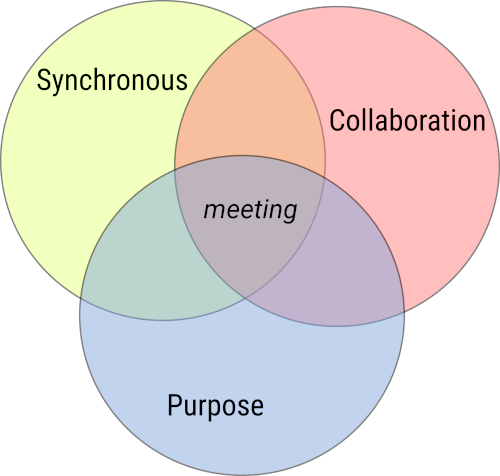
It’s synchronous. We’re in a shared space at the same time, together.
There’s collaboration. The participants in the meeting are interacting with each other.
It has a purpose. At the end of the meeting we want to have achieved something. We may fail at achieving that purpose during the meeting, but that’s ok.
If a meeting doesn’t need to be synchronous, it could have been an email. Or a Slack message. Or a pull request. Or any other form of asynchronous communication.
If a meeting doesn’t need any collaboration, it’s a speech. It’s one-way communication, a broadcast.
If a meeting doesn’t need a purpose, it’s a game. Not that games and play don’t serve a purpose, but what you do and create in the game, does not have a purpose outside the game.
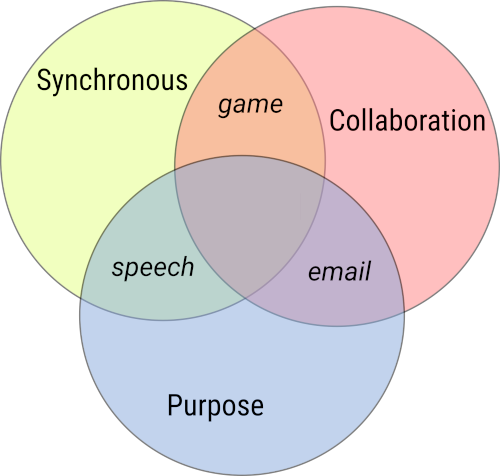
You are already doing this
What’s interesting to me is that, some of your meetings are like this already. Your daily standup, your retrospective, a brainstorm session. They are synchronous collaboration with a purpose - or at least, I hope they are. They are meetings in which you do the work of coordinating, reflecting, coming up with new ideas.
And you can take this idea of doing your work in meetings a lot further, to where all your work happens in a ‘meeting’, i.e. ensemble or mob programming.
With Mob Programming, our entire day is a working meeting, and more like a workshop than a meeting. We are working together, not merely “meeting”.
- Mob Programming by Woody Zuill and Kevin Meadows
You may not want to take it that far, but the idea still applies. There are no meetings. There’s only work, some by yourself and some in a group.
The need for artful participation
So problem solved? Remind yourself that a meeting should be synchronous collaboration with a purpose and you’ll only have perfect meetings from now on?
Unfortunately, no. It’s good to have it as a heuristic, but something else is needed as well. Leadership.
Or as Sociocracy 3.0 puts it, artful participation: “Is my behavior in this moment the greatest contribution I can make to the effectiveness of this collaboration?”
Meetings are something that happens to us
A meeting will never be a good meeting if we experience it as something that happens to us, as something that’s imposed on us.
In his book “Orbiting The Giant Hairball” Gordon Mackenzie tells the story of how he facilitated a brainstorm session for a task force, after sitting through the incredibly boring and unengaging first part of their meeting. He started with an exercise, using candles and a pair of Tibetan cymbals, to help the attendees let go of their notions and biases of where they thought the meeting would or should go. Thanks to that exercise, the brainstorm proceeded in a completely different way than the previous part of the meeting:
Release from their inculcated culture allowed the task force members to metamorphize - for a little while - from mere attendants at a meeting into vibrant participants in an evolving endeavor. (p206)
Isn’t that how all meetings should be? Not with attendants, but with vibrant participants in an evolving endeavor?
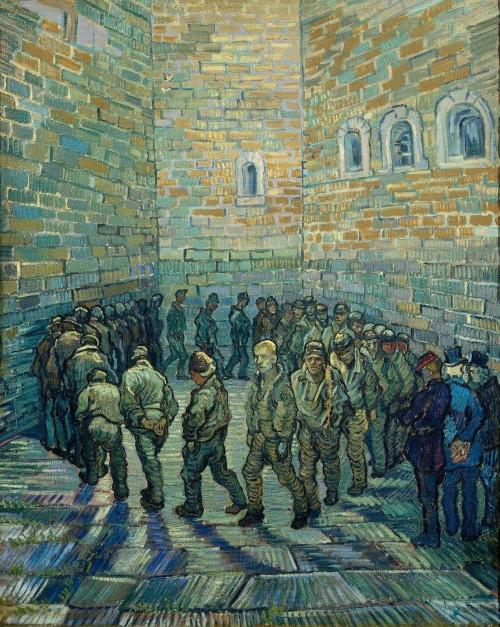
Leadership and the three core human capabilities
In her book No More Feedback Carol Sanford describes three core human capabilities and how they ideally should be developed.
internal locus of control
Internal locus of control means that you feel control over your own life. You take accountability of outcomes and direction.
external scope of considering
External scope and considering means that you take other people and living beings into account in your actions and endeavors.
personal source of agency
Personal source of agency means that you feel that you yourself have the authority to initiate actions and to follow through.
It’s these capabilities we need to truly participate in a meeting. They prevent us from making the organizer or facilitator solely responsible for the success of the meeting. From only focusing on what we ourselves need to get out of the meeting. They encourage us to be skillful participants. To display leadership during meetings. Not leadership as in taking charge and running the show, but leadership in the way Jerry Weinberg defined it:
creating an environment where everyone can contribute to solving the problem.
Improve meetings through small acts of leadership
GeePaw Hill once said:
Why do people have long breakless meetings, when everyone in the room dislikes it, and everyone in the room knows it doesn’t work very well?
If that is true, it doesn’t take a lot to change it. A small spark is probably enough. And often a small spark, acting as a catalyst, is better than swooping in with a big change. Start where you are - as an individual, as a team, as an organization.
To close off this post, I want to share some examples of things I’ve done that improved a meeting. I’ve split them in three categories: attending to time, to structure, and to people.
Attending to time
25 or 50 minute meeting: set the times on your invite so there’s time for a break after and stick to those times
decline a meeting: if you don’t need to be there, if attending doesn’t seem useful, politely decline and don’t go
suggest a break: observe the energy in the room and at the right time, suggest a short break
leave the meeting: if a meeting turns out not be useful for you, excuse yourself and leave
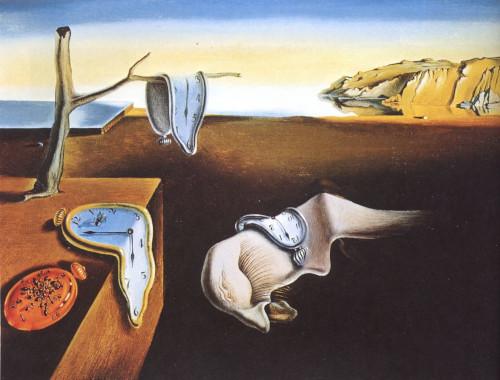
Attending to structure
ask to zoom in: if someone is sharing their screen and it’s hard or even just uncomfortable to read, ask them to zoom in
write/draw and share: if there’s a lot of conversation without notes or diagrams, start making them and share them as you make them
ask for a document upfront: ask if you can do anything to prepare for the meeting, e.g. reading a document
move a chair, open a window: improve the space the meeting is held in, make it more pleasant

Attending to people
amplify others: contribute to everyone’s voice being heard, especially if you’re in a position of privilege
give credit: if something you do or say wouldn’t have come to be without someone else, give them credit, whether they are present or not
express appreciation: if someone does something to make the meeting a better meeting, express your appreciation - either during or after the meeting
make space to be human: meetings should be effective, but make sure there’s also space for social interaction, for emotions, for being a human being1
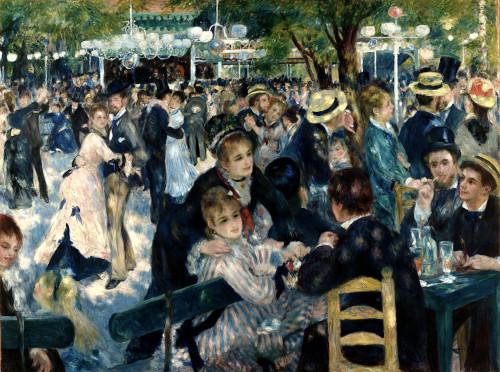
Something I strongly believe about change is that small things done consistently, will beat any grand interventions. So in your next meeting I encourage you to ask yourself: what’s a small thing I can do to make this meeting better?
This post is based on my AgileTD 2020 talk “Making meetings work”.
-
Shout-out to Emily Webber for her comment on my post that made me realize I had forgotten to include this. ↩